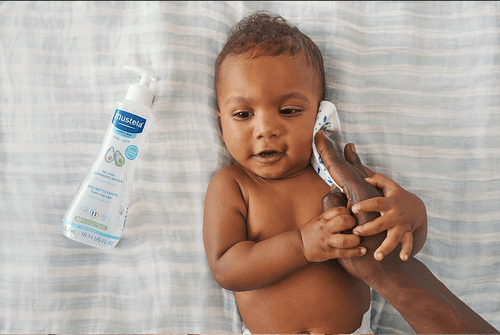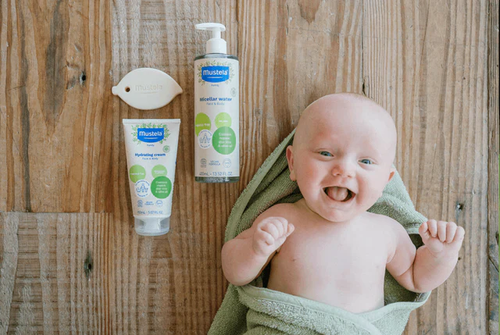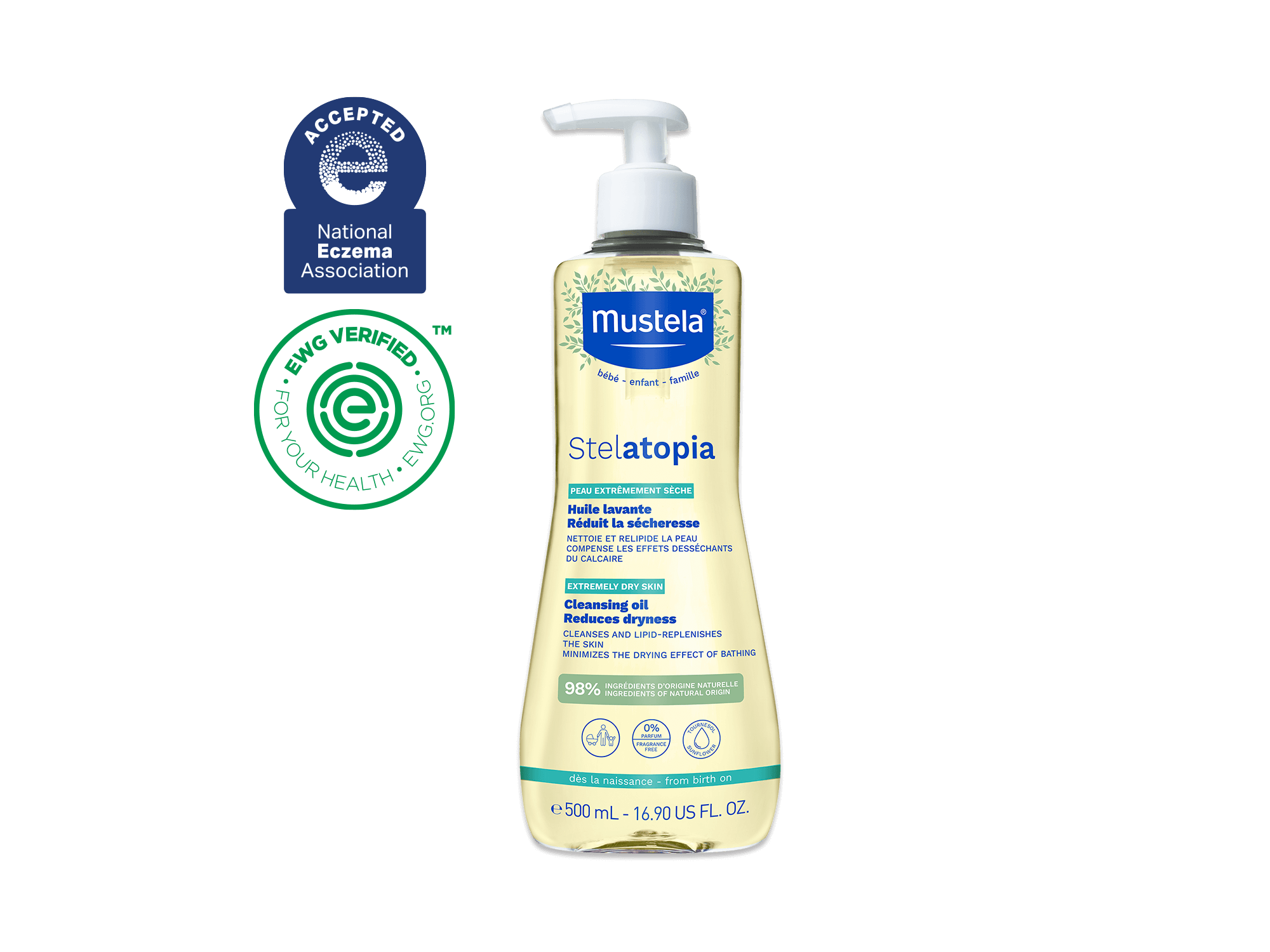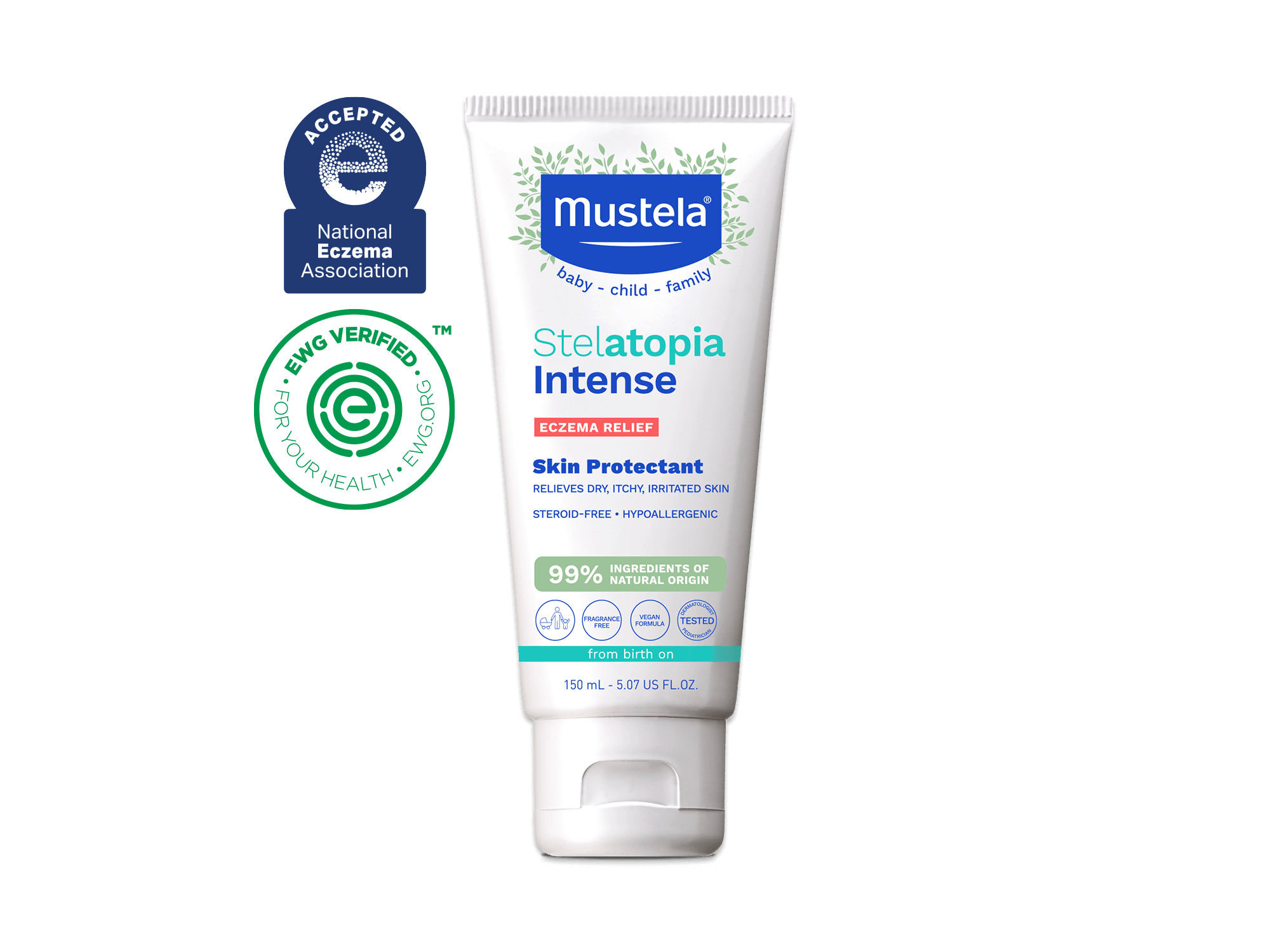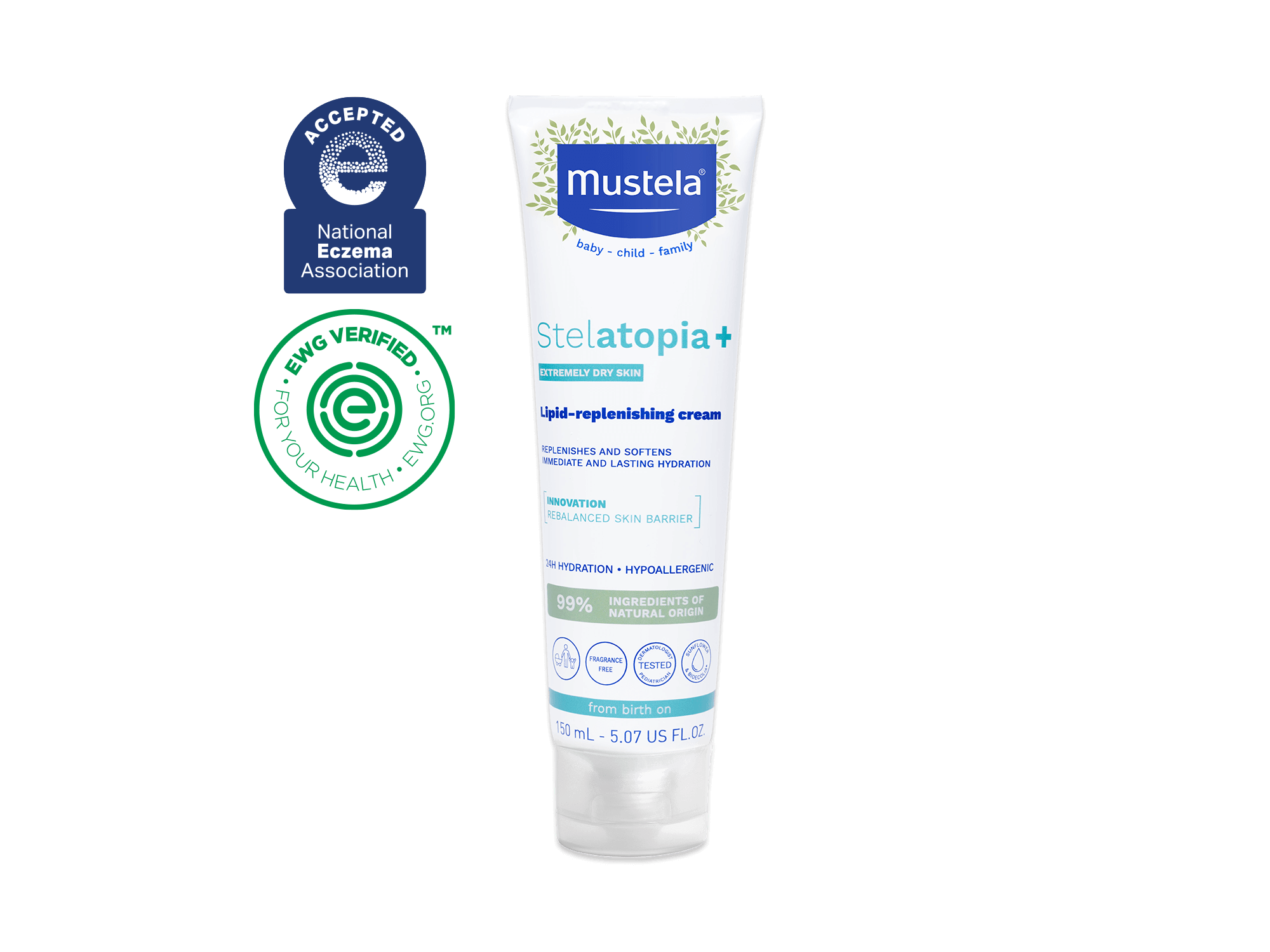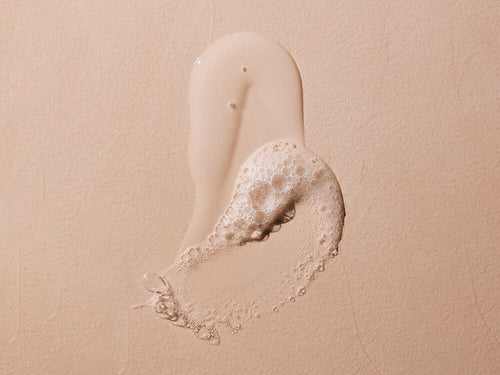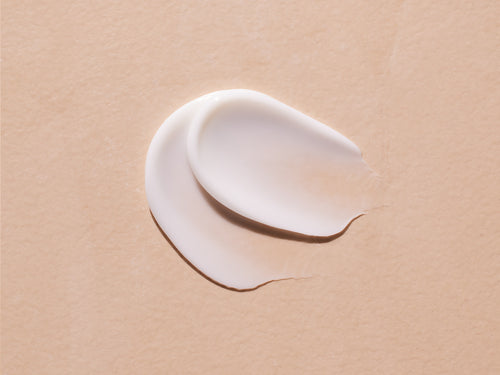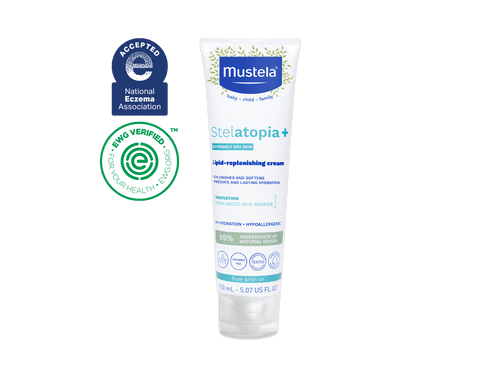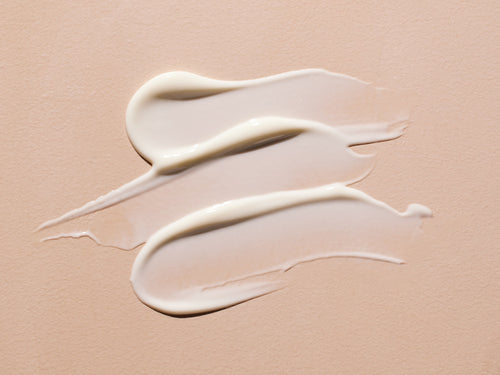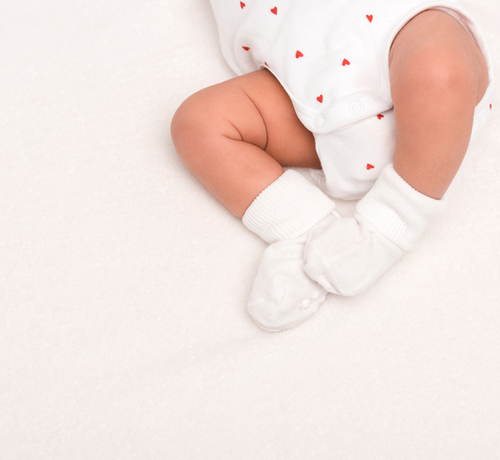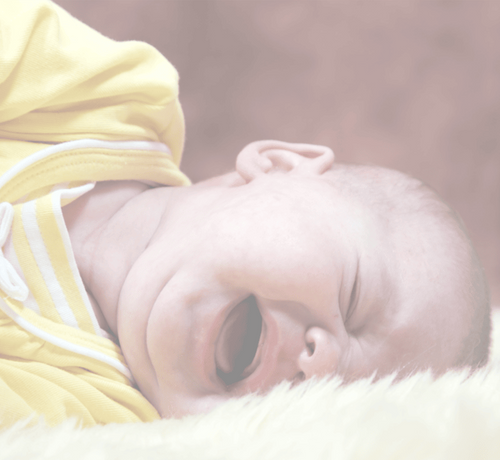Have you noticed red, itchy patches on your little one’s delicate cheeks or forehead and wondered what it could be? It could be baby eczema on the face, a common skin condition that affects many infants and young children.
While there’s no cure for eczema, you can take steps to manage and treat your baby’s symptoms. In this guide, we’ll cover everything you need to know about baby eczema on the face, from its symptoms and causes to treatment options.
Key Takeaways
- Eczema is a common skin condition that causes inflammation and itchiness. In the United States, about one in 10 children develop eczema.
- Of the different types of eczema, atopic dermatitis is the most common.
- Common causes of baby eczema include skin irritants, allergens, genetics, and environmental triggers
- To treat baby eczema on the face, or other parts of their body, do your best to avoid triggers, implement a simple skincare routine, try home remedies, moisturize multiple times a day, and talk to your doctor about preventing flare-ups.
What Is Eczema?

Eczema is a common skin condition that causes inflammation and itchiness. In the United States, about one in ten children develop eczema.
Of the different types of eczema, atopic dermatitis is the most common. That’s the sort we’re going to focus on in this article.
Who Gets Eczema?
Eczema can affect anyone. However, babies and children are most likely to develop this condition. About 60% of people with eczema were diagnosed before their first birthday.
While eczema isn’t contagious, it does tend to run in families. If you or your partner have it, your child is more likely to develop the condition. Parental allergies and asthma are also risk factors for baby eczema.
Where Does Eczema Occur?
Your baby can develop eczema anywhere on their body. However, you’ll most often notice symptoms on the:
- Face
- Hands
- Feet
- Arms and legs
Baby eczema on the face is most often on the cheeks and chin. It can also affect your little one’s forehead, nose, or scalp.
Symptoms Of Baby Eczema On The Face
Eczema typically results in patches of dry, itchy skin. You may also notice the following symptoms:
-
Redness
-
Trouble sleeping
- Crusting or oozing skin
-
Peeling areas
- Skin feels rough to the touch
- Swelling
- Dark-colored patches
- Thickened skin
Eczema doesn’t affect everyone the same way. It can be mild or severe. In addition, your baby’s eczema may seem to come and go throughout their early years. This is normal, as the condition can flare up due to specific triggers, which we’ll discuss later.
What Causes Baby Eczema?
Scientists have yet to determine the exact cause of eczema. It’s believed to be a combination of genetic and environmental factors.
Let’s look at a few known contributors.
Skin Irritants
All babies have sensitive skin. But for babies with eczema, certain ingredients and fabrics can irritate their skin more than normal.
Common irritants include:
- Laundry detergent
- Scented fabric softeners
- Perfumes
- Harsh soaps
- Hot water
- Wool
- Synthetic materials
Allergens
Babies with allergies are more likely to develop eczema. Allergies can fall into two main categories: environmental and food.
Environmental allergies include dust mites, pollen, and pet dander. Common food allergies are dairy, eggs, soy, and wheat.
If you suspect your baby has allergies, consult their pediatrician for testing and confirmation. This way, you know for sure what foods or other allergens to avoid.
Genetics
As we mentioned earlier, eczema is believed to have a genetic component, though scientists are still trying to pinpoint the specific genes involved. The current theory is that babies with eczema may have a mutation in the FLG gene, which affects the production of filaggrin.
Filaggrin is a protein that helps maintain the skin barrier and lock in moisture. When there’s a problem with this gene, it weakens the skin barrier, making it easier for irritants and allergens to enter the body.
Triggers
Even if your baby has a genetic predisposition to eczema, it doesn’t mean they’ll automatically develop the condition. Certain triggers can cause flare-ups or worsen existing symptoms.
Some common eczema triggers include:
- Stress
- Extreme temperatures (hot or cold)
- Dry skin
- Sweat
- Dry air
- Dust mites
- Smoke
It can take time to determine what triggers your baby’s eczema. Keeping a skin log can help you identify patterns.
Understanding the Eczema-Allergy Link
We mentioned before that babies with allergies are more likely to develop eczema on their face, legs, arms, hands, and feet. This connection is so strong that doctors often call it “the atopic march”.
The atopic march is a way that allergic conditions develop in children over time. Think of it like a progression or path that starts with skin reactions that can lead to food allergies, hay fever, and even asthma.
Here’s the progression in a bit more detail.
Step 1: Eczema
Eczema is often the first sign that the atopic march is underway. The appearance of eczema shows that your baby’s skin barrier is weak. If not treated correctly, it can lead to further issues.
Step 2: Food Allergies
Some babies with moderate to severe eczema may also develop allergies to foods such as milk, eggs, peanuts, and soy.
How does this happen? The weakened skin barrier may allow tiny food particles to enter your baby’s body. This can trigger a reaction and teach their immune system to attack those types of particles, whether they enter through the skin or through the mouth.
Step 3: Hay Fever
The sensitivity brought on by eczema and food allergies can lead to other reactions, this time to things in the air, such as pollen, dust mites, and pet dander.
These reactions typically start at around 3-5 years old and can lead to sneezing, a runny nose, and itchy eyes (i.e., hay fever).
Step 4: Asthma
Later, some children may develop asthma, which is a condition that makes the airways in the lungs swell up and get narrow, making it hard to breathe.
Not every baby with eczema will go through all of these steps, especially with proper treatment, but knowing about the atopic march is still very important.
If your little one has severe eczema, talk to your doctor about allergy testing. This can help you manage or even avoid some of the later steps in the atopic march.
Treating And Preventing Baby Eczema On The Face

Now that you know more about baby eczema on the face, let’s discuss ways to help treat and manage this condition.
Avoid Triggers
Once you’ve identified your child’s triggers, minimize or avoid exposure. For example, if dry air worsens your baby’s skin, use a humidifier in their room to try to raise the amount of moisture in the air.
If dust mites are a problem, regularly wash their bedding and vacuum the carpet often to help reduce the amount of dust in their environment.
Here are some other ideas for managing exposure to triggers:
- Dress your child in light, breathable clothing
- Use mild, fragrance-free products on their skin and avoid harsh chemicals
- Keep their bath time short and use lukewarm water
- Integrate play time into the day and plenty of rest to help reduce stress
- Minimize your child’s time around people who smoke or around areas with high levels of air pollution
While you may be unable to avoid all triggers, being intentional about them can help keep your baby’s skin looking (and feeling) better.
Implement A Simple Skincare Routine
Keeping your baby’s skin clean and moisturized is key to managing their eczema. But you also need their skincare routine to be manageable so you can be consistent.
Here’s an example of a simple skincare routine you can implement:
- Give your baby a quick bath every day. Use lukewarm water and products designed for eczema-prone skin, such as our Stelatopia Cleansing Gel.
- Apply a gentle moisturizer immediately after bathing while their skin is still damp. Our Stelatopia Emollient Face Cream is an excellent option.
- Use mineral sunscreen on babies over six months old
These three steps won’t take long, but they can make a big difference in your baby’s skin health.
Try Home Remedies
In addition to an eczema-friendly skincare routine, you can try some natural home remedies to alleviate your baby’s symptoms. You may need to experiment to find the right therapy for your child since everyone’s eczema is different.
Here are a few options to consider.
Oatmeal Baths
Adding ground-up oatmeal to your baby’s bath water can help soothe their skin and reduce inflammation.
Cool Compresses
If the eczema itch is bothering your baby, a cold compress can help. Simply soak a cotton cloth in cold water, then wring it out.
Place it on the itchy patch and hold it there for a few minutes. Remember to moisturize the area when you remove the compress.
Avocado Paste
Extracts from avocados can help relieve symptoms and hydrate your baby’s skin. If you don’t want to rub a squished-up avocado on their face, try our Stelatopia Intense Eczema Relief instead.
Its Avocado Perseose and other natural ingredients help restore the skin’s moisture barrier. Plus, the formula is dermatologist and pediatrician-tested, so you can feel good about using it on your little one’s delicate skin.
Sunflower Seed Oil
Sunflower seeds are known for their anti-inflammatory properties, which can help eczema. Apply a small amount of this oil to your baby’s skin.
You can also look for skincare products that use sunflower oil, such as our Stelatopia+ Lipid Replenishing Cream Pump. It continuously nourishes and moisturizes your baby’s skin for up to 24 hours after application.
The gentle formula is a great addition to their daily skincare routine.
Oil Bath
Bathing in water can remove moisture from the skin. But adding a couple of drops of Stelatopia Cleansing Oil to the bath water can help minimize this loss and replenish your baby’s natural oils.
However, the oil will make the bathtub slippery, so be cautious when taking your little one out of the water.
Moisturize

Dry skin can worsen eczema, so take steps to keep your little one’s skin hydrated. After bathing, apply a gentle moisturizer designed for babies with eczema-prone skin. This is especially true for your baby’s face. It’s always exposed to the world, so it needs special care.
Here’s a simple way to combine a bath with eczema treatment and prevention.
Right after their bath, your baby’s skin is full of water. To lock that water in, gently pat (don’t rub) your baby’s skin mostly dry and then immediately put on a thick layer of moisturizer or cream. Look for a non-greasy formula that absorbs quickly.
Reapply the cream to their face several times a day, especially after they drool, spit up, or eat. To gently remove these potential triggers, dab their skin clean with a perfume-free wet wipe like Mustela’s Home Compostable Fragrance-Free Wipes and then apply the cream.
Talk To Your Doctor About Medications
Sometimes, home remedies aren’t enough to clear your child’s eczema. Discuss their skin with their doctor if their symptoms aren't improving.
The medical team can help you develop a treatment plan. This could include medication or a change in your child’s skincare routine. They may also suggest specific products to use during flare-ups.
While medications can be helpful, they can also have side effects. Your doctor will discuss these with you and ensure the benefits outweigh the potential risks.
As we discussed earlier in this article, triggers such as stress, dry air, sweat, and dust mites can cause eczema to flare up, or get worse, for a time.
Preventing these flare-ups is often easier than treating them once they start. And, since your baby’s face is always exposed to the world, it needs special care.
Here are some tips to help you prevent eczema flare-ups on your baby’s face.
Be Mindful Of The Temperature
Both heat and cold can cause eczema to flare up on your baby’s face. To prevent this, be mindful of the temperature.
Heat: Heat and sweat are major eczema triggers, and babies often get hot quickly, especially on their face and neck.
When you’re out and about in the summer, make sure their car seat cover or stroller blanket doesn’t make their face too warm, and use a light, soft cotton hat to protect their face from the sun.
When you’re home, keep the temperature cool, especially at night. Most experts recommend between 68°F and 72°F to minimize the risk that heat and sweat will trigger a flare-up.
Cold and wind: Cold, dry air can suck the moisture out of your baby’s skin. So, before going out in the winter, cover the exposed areas of their face with an extra layer of thick, protective balm such as Stelatopia Emollient Cream For Face.
Add a light scarf or hat to shield their cheeks and chin from the wind.
Protect Baby’s Face From Food And Drool
When your baby eats, food and drink can irritate their skin and cause a flare-up. Prevent this by cleaning their face with a soft, damp cloth or wipe immediately after they eat. Then reapply a moisturizer to keep their skin from drying out.
Food and drink on their face aren’t the only things that can cause an eczema flare-up. Drool can too. Drool is slightly acidic, and when it sits on your baby’s sensitive skin, it can quickly cause irritation around their mouth, chin, and neck.
Use a soft cloth to gently dab the drool away (don’t rub) and then apply a thick cream or balm to their chin and cheeks to protect their skin from wetness and irritation.
When To Take Your Baby To The Doctor For Eczema
Even though baby eczema is very common and can be managed at home, there are times when you should seek help from a doctor or dermatologist.
Here are some signs that mean it’s time for a doctor’s visit.
Your Baby Can’t Sleep
Eczema can be very itchy. And this itch can get worse at night when they’re trying to sleep. They may scratch so much that they wake themselves up over and over again.
If you notice your baby is itching more than usual and is cranky or upset during the day, it may be a sign that the current treatment isn’t working well and you should talk to a doctor.
The Patches Look Infected
Sometimes, your baby may scratch so much that they break the skin and let germs in. This can lead to an infection.
Talk to a doctor or dermatologist right away if you notice any abnormal symptoms, such as yellow or honey-colored crust on top of the eczema patch, oozing or weeping, pus-filled bumps, swollen skin, or a fever.
One or more of these symptoms may mean that an infection is present and your baby may need special medication from a doctor or dermatologist.
Home Remedies Aren’t Working
If you’ve been carefully following a gentle skincare routine for your baby, avoiding triggers, and using an over-the-counter eczema cream, like Stelatopia Intense Eczema Relief, for two weeks but the eczema isn’t getting better or is getting worse, it’s time to see a doctor.
The Eczema Covers A Large Area
If the eczema has spread from where it started and covers a large area or new parts of their body, your little one may need a stronger medication that only a doctor, pediatrician, or dermatologist can prescribe.
Soothe Your Baby’s Eczema With Mustela

Baby eczema on the face can be uncomfortable for your little one and stressful for you. But with a consistent skincare routine and gentle products, you can soothe your baby’s eczema and help them find relief.
Mustela offers a wide range of products specially formulated for babies and children with eczema-prone skin. This line is gentle, hypoallergenic, fragrance-free, and chock-full of natural ingredients that nourish and moisturize your baby’s skin.
So don’t wait; try Mustela today and see the difference it can make. Your child deserves to feel comfortable in their own skin!
Frequently Asked Questions
What bedding and pajamas are best for baby eczema on face?
Bedding made of 100% cotton is your best bet for a good night’s sleep.
From birth to 12 months old, cover their crib mattress with a cotton sheet and dress them in a cotton onesie, cotton pajamas, cotton sleep sack, and or cotton swaddle to keep them warm. Babies under 12 months old should not sleep with a separate blanket.
When they’re old enough (typically between 12 and 18 months), they can sleep with a separate blanket, but avoid heavy or synthetic fabrics that can trap heat and cause sweating.
Wash all bedding and pajamas at least once a week in a gentle, fragrance-free detergent.
Can a bedtime routine help my baby sleep better when they have eczema on their face?
A bedtime routine is a great way to help your baby relax when it’s time for bed, even when they have eczema on their face.
Keep in mind that it doesn’t have to be extensive or complicated to work. Simple activities such as a lukewarm bath, applying cream, and a gentle cuddle are perfect before bed.
For best results, keep this routine the same every night to help your little one wind down, even when they’re itchy.
Can I take my baby to the doctor even if I only have questions?
There’s absolutely nothing wrong with talking to a doctor, even if you only have questions.
If you’re confused about how to manage eczema or want to know if there are stronger treatments available, a pediatrician or dermatologist can help you develop a clear plan for treating your baby’s eczema and give you peace of mind in the process.

